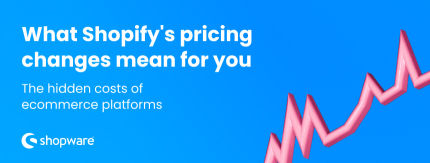
The ecommerce industry is at a crossroads, with recent pricing adjustments by Shopify sparking a broader conversation about platform costs, value, and alignment with business needs. For many merchants, these changes are not just about numbers; they're about the fundamental aspects of running a successful online business in a competitive landscape.
The rising costs of staying put
Shopify Plus price increase
Shopify's decision to increase its pricing, particularly for Shopify Plus users, from $2,000 to $2,500 per month*, coupled with the additional transaction fees for those not using Shopify Payments, presents a tangible challenge.
Shopify transaction fee increase - a "penalty" fee
The transaction fee adjustment from 0.15% to 0.2% may seem minor at first glance, but its impact is far from negligible. For a business processing $1M in Gross Merchandise Value (GMV), this "penalty" escalates from $1,500 to $2,000 annually. Scale that up to $50M in GMV, and the cost leapfrogs from $75,000 to a staggering $100,000. This increment is not just a line item; it's a significant expense that could be allocated towards growth initiatives, marketing, or enhancing customer experiences.
Decision criteria for ecommerce platforms
In the face of these changes, it's crucial for merchants to reassess their platform choices based on a set of comprehensive decision criteria:
Total Cost of Ownership (TCO): Consider not just the base platform fees but also the ancillary costs associated with transaction fees, required third-party applications, and the potential "penalties" for not adhering to platform-specific payment solutions. Watch a free masterclass on TCO and learn how to calculate the real costs of your ecommerce projects.
Implementation and Maintenance: Evaluate the ease of migration, the level of ongoing maintenance required, and the availability of support to ensure smooth operation.
Flexibility and Scalability: Assess whether the platform can adapt to your business's evolving needs without incurring prohibitive costs or complexities.
The forgotten mid-market and Shopware's solution
The plight of the mid-market in ecommerce—a segment often overlooked by major platform providers—underscores the need for a solution that bridges the gap between SMB simplicity and enterprise-grade functionality. Shopware emerges as a compelling alternative in this context. With its open-source foundation, Shopware offers unparalleled flexibility, empowering merchants to customize their online stores to their exact specifications without being constrained by the platform's limitations. Talk to us to find out more!
Shopware: a partner for growth, not just a platform
Shopware's ethos is built around supporting the mid-market with a robust, scalable, and cost-effective ecommerce solution. By choosing Shopware, merchants can avoid the escalating costs associated with other platforms and invest in what truly matters: growing their business and enhancing their customers' online shopping experience.
As the ecommerce platform landscape continues to evolve in 2024, it's more important than ever for merchants to make informed decisions about their platform choices. With the recent pricing and fee changes by Shopify, now is an opportune time for businesses to explore how Shopware can provide a more sustainable and growth-oriented ecommerce solution.
Further Reading
"The US mid-market ecommerce platform sector is a wasteland!"
Rick Watson, commerce legend and well-known straight shooter, recently conducted research into the situation of US mid-market merchants and their choice of ecommerce platforms. The report "Breaking Up Is Hard to Do: The Journey of the Mid-Market Merchant" can now be downloaded for free. Click on the button below to get it!
*$2,300 per month if you sign up for three years.










